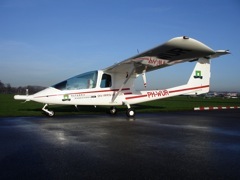Aircraft

More Info
The aerial platform, which was developed for the EU-FP5 RECAB-project, is based on the certified aircraft Sky Arrow ERA (Environmental Research Aircraft), equipped with sensors to measure three-dimensional wind and turbulence together with gas concentrations and other atmospheric parameters at high frequency. The aircraft engine is mounted in a pusher configuration and has a cruise flight-speed of 85 knots with an endurance of 3.5h, allowing it to cover flight distances of up to 400km. Operating altitudes can range from 10m above ground level to more than 3500m above sea level.
Atmospheric turbulence measurements are made with the "Best-Aircraft-Turbulence Probe" (BAT-probe), developed by NOAA's Atmospheric Turbulence and Diffusion Division (NOAA-ATDD) and Airborne Research Australia (ARA). In brief, the BAT-probe measures the velocity of air with respect to the aircraft using a hemispheric 9-hole pressure sphere that records static and dynamic pressures by means of four differential pressure transducers [Crawford and Dobosy, 1992]. The Sky Arrow, allowing the BAT-probe to be installed directly on the aircraft’s nose, thus minimizing airflow contamination due to up-wash and side-wash generated by the wing [Crawford et al., 1996].
The actual wind components (horizontal U, V and vertical W) relative to the ground are calculated introducing corrections for three-dimensional velocity, pitch, roll and heading of the aircraft. Those corrections are made using a combination of GPS velocity measurements and data from two sets of three orthogonal accelerometers mounted at the center of gravity of the aircraft and in the centre of the hemisphere. The GPS and accelerometer signals are blended to obtain attitude and velocity data at frequencies up to 50Hz. Accordingly, atmospheric turbulence is actually measured at a frequency of 50Hz and since the aircraft can fly at relatively slow speed (35m/s), a horizontal spacing of 0.7m between 50Hz measurements in no-wind conditions can be achieved. In this way, eddies of wavelengths larger than 1.4m can be detected.
The probe is equipped with a micro-head temperature sensing element to measure air temperature with a response time of 0.02s. A platinum resistance thermometer is used for a mean air temperature reference. A net radiometer (Q*7, REBS USA) and upward and downward looking PAR radiometers (200s, Li-Cor, USA) are mounted on the aircraft's horizontal stabilizer. Low frequency air moisture measurements are made using a chilled mirror dew point sensor (EdgeTech, USA). Surface temperature is also measured at 1Hz, using an infra red thermometer (4000.4 GH, Everest, USA).
Atmospheric densities of carbon dioxide and water vapour are recorded at 50Hz by a Li-Cor 7500 (Li-Cor, USA) open path infrared gas analyzer installed on the aircraft nose. All the digitally converted signals from the BAT-probe and the sensors are stored on a computer located on-board. Additional details of underlying theory and the technical implementation of flux aircrafts can be found in Crawford and Dobosy [1992] and Crawford and Hacker [2001], Brooks et al. [2001], Dumas et al. [2001].
The subsequent calculation of carbon dioxide, water vapour, sensible and latent heat and momentum fluxes are made using conventional eddy correlation technique taking into account all the necessary corrections for open-path gas analyzers, frequency response loss, and stationarity corrections. The main difference between airborne and ground-based eddy covariance is in the averaging technique.
Turbulent fluctuations (wind and associated scalars) are calculated using averages calculated over space (per meter) rather than over time (per second). The definition of a proper averaging length is critical to ensure that all significant flux-carrying wavelengths are taken into account. Such a length depends on the flying altitude, on the surface roughness, and on atmospheric stability. Using such an approach, proper averaging lengths ranging from 3500m to 4500m have been found in the different conditions encountered in the campaigns and have been used to calculate fluxes.
The fluxes thus measured have been widely validated against a number of tower flux sites across Europe and in different seasons [Gioli et al., 2004]. It has also been used to study CO2 flux divergence and entrainment in the ABL [Vilà-Guerau de Arellano et al., 2004].

